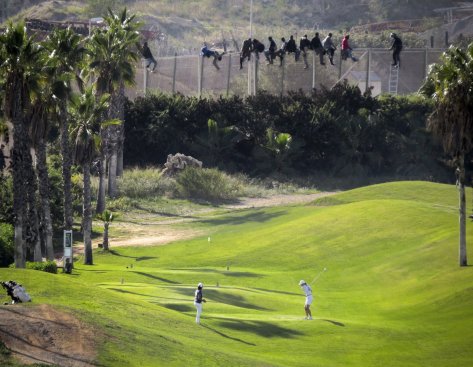The above photo was taken by José Palazón, of the migrant rights Pro.De.In group in Morocco on the border between what is officially Morocco and Spain’s enclave of Melilla. This city has been Spanish since its conquest by Queen Isabella and King Ferdinand in 1497, and is still acknowledged by the current rulers, who visited in 2007. Morocco, however, has demanded the return of these territories’ as they are a remnant of the colonial past. Spain arguing that since it owned them before Morocco gained independence from France (1956) they are Spanish by right. The region is absent from the UN list of Non-Self-Governing Territories, while other areas in the region, such as Gibraltar (UK-governed, Spanish claim), are.
This image shows migrants from across Africa attempted to enter Europe by climbing the fence marking the border, which on the Spanish side has the Club Campo de Golf en Melilla, a public golf club where a single game can cost nearly $30. The idea of a transnational space that both transcends geographical boundaries and creates new ones is starkly illustrated–as the area is recognised as literally part of Spain, migrants can enter Europe while not only never reaching the continent, but never leaving what, particularly for Moroccan immigrants, is viewed as their own country in the first place. The irony is many Western-centric drivers of an outwardly more transnational approach, such as the EU, often end up with a version that just follows all the historical patterns.
Katie Day

The image of the migrants sitting on the fence is a powerful one. Even though the viewer of this image can only see one side of the fence, it is blatantly clear that there is an entirely different world on the other side.
This discussion of Span’s theft of African territories reminds me of America’s theft ( and distribution) of lands that used to belong to the Native Americans. Within the United States, we have reservations, which have tribal sovereignty. The socioeconomic and physical landscapes of reservations differ greatly from the rest of the U.S.
–Kailyn Amory
LikeLike
I wonder what the characteristics are of this specific transnational space–a question that I have had regarding the many configurations of transnational spaces that we have encountered. I understand that the question itself is quite loaded. I wonder if it is even an important question, after all.
Still, since having read “A Transnational Poetics,” I find myself increasingly curious as to the factors which are involved in ascribing influence in (or shaping) a certain transnational space. We have a piece of Moroccan land (Morocco as historically French-ruled) that is itself historically Spanish- ruled, but certainly has its own set of customs that might not necessarily be considered “traditionally” Spanish or French or Moroccan. So what do we call those? And how did they come about in just that way?
How does Melilla’s apparent value to Spain configure into the way in which its transnational shape took form?
Sarah
LikeLike
This picture is really powerful in the narrative and message it gives out. It seems like the ‘normal’ life of golf players is subtly contrasted by the lives of people trying to cross the fence. I wonder whether this golf club has any policy as to what to do in these cases… Once again, this picture is a strong depiction of how stark differences can be created by imaginary geographical and political and social boundaries.
-Andreanne
LikeLike